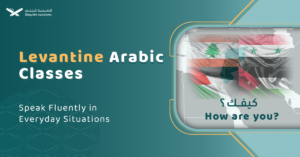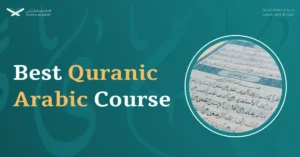Learning about definite and indefinite particles in Arabic language is a crucial topic. It is an important and building-block knowledge for all levels of all Arabic language learners. Acquiring the grammatical concept of definite and indefinite articles will definitely help you to understand the structure of the Arabic nominal sentence syntaxes.
In Arabic language, however, there is only one direct definite article, which is a two letters prefix attached to the beginning of an Arabic word.
Difference between Definite and Indefinite Articles in Arabic:
The main difference between definite and indefinite articles in Arabic is that the definite article “al” (ال) is a prefix attached to a noun to indicate definiteness, whereas indefinite nouns are simply written without “al” and are marked with “tanween” diacritics (double fat-hah, dammah, or kasrah).
The definite article “al” is consistent in form, but its pronunciation varies depending on the following letter (sun or moon letters), while the indefinite state is indicated by the absence of “al” and the use of tanween.
Let’s discuss them in details:
Definite Articles in Arabic
The Arabic definite article “Al / ال”, is made up of Alif and Laam letters, and it is only used for the definite state. On the other hand, there is no prefix or specific particle for the Arabic language indefinite state. It is mainly signified by not using the Arabic definite particle (al / أداة التَّعْريف ال).
In this article we will cast some light on the different aspects of the definite and indefinite articles in the Arabic language. Go no further.
Types of Arabic Definite Articles With Examples
In this section, we will present the different definite articles in Arabic with examples. Firstly, you have to realize that there are many ways, other than “al”, by which Arabic words can be turned into definite. These ways include the use of some Arabic linguistic tools. They are as follows:
1. Identified Nouns “Identifiers”
Some nouns in Arabic language are naturally considered definite names without the need to use any definite article before them. These nouns are called the identifiers / ُالاسْمَاءُ المُعْرَفة. This category includes persons’ names such as Omar / عمر, Nasser / ناصر, Sama / سما, or city names such as Cairo / القاهرة, London / لندن …. etc.
2. Personal Pronouns
A personal pronoun can be considered as a definite particle to a singular or plural noun that follows it.
Example:
A. I am a boy.
أْنَا وَلَدٌ.
Ana waladon.
B. You are Egyptian.
أْنّتَ مَصْري.
Anta masry.
C. He is a good man.
هوَ رَجُلٌ صَالِح.
Hwa rajolon saleh.
3. Demonstrative Pronouns
A demonstrative pronoun such as (This / هذا, These / هؤلاء) can be considered as a definite particle to a singular or plural noun that follows it. Check Shaykhi Academy’s Learn Arabic Online Course for more details
Example:
A. I want to buy this book.
أُرِيدُ أنّ اشَّتَري هَذا الْكِتْاب.
Ureedo an ash’tare hadha al-Ketab.
B. This is a brave boy.
هَذا وَلَدٌ شُجَاعٌ
Hadha Waladon shoga3on.
C. This woman is selfish
هَذِه امْرَأةٌ أنَانيةٌ
HaDhehe amra’aton a’na’neyton.
D. These are two small cats .
هًذان قِطان صَغيرَان
Hadhan kit’taan sa’gheran.
4. Relative Pronouns
A Relative pronoun such as, (who or which) can be considered as a definite particle to a singular or plural noun that precedes it.
Example:
A man who came in.
الّرَجُل الّذي أَتَى.
al-Rajol al-Ladhi ata.
5. Possessive Pronouns
A Possessive pronoun such as, (My, His, Her) can be considered as a definite particle to a singular or plural noun that precedes it.
Examples:
My cat قطتي
Your cat قطتك
His cat قطته
Her cat قطتها
Our cat قطتنا
Their cat قطتهم
6. Calling Particles
Such calling particles or calling words; which we use to call someone; can be considered as a definite particle to a singular or plural noun that follows it.
Examples:
A. Hey; guy
يَا رَجُل
Ya rajol.
B. Hey; guys
يَا رِجَال
Ya rejal.
The Definite Article (AL) / Laam At-Ta3ref (ال)
The article AL (ٱلْـ) – also transliterated as EL (اِلِ) or IL (اِلْ) or A (َا)– is the main definite article in the Arabic language. Here is a quick presentation to its different linguistic aspects: –
1. The Formation of The Definite Article (AL) / Laam At-Ta3ref (ال
Unlike most other Arabic definite particles, the definite particle [Al / The] is always attached to the beginning of a word. It never stands alone as an independent word. The word that is attached to the article Al (the), is often a noun or an adjective.
The definite article “al” is not modulated because of gender or number or any grammatical cases. It stays the same without any change with all that mentioned above. It is used for all noun cases, genders and numbers…etc.
Examples:
The apple ُالتٌفَاحَة (Singular)
The two apples التُفَاحَتْان (Dual)
The apples التٌفَاحُ (Plural)
The Definite Article “al” can be attached at the beginning of a noun or an adjective.
Example:
الْبنّتُ / al-Bento / The girl
الَّبنتُ الطَويلَة / al-Bento at-Tawelato / The tall girl
2. The Function of The Definite Article (AL) / Laam At-Ta3ref (ال)
The function of the definite article (al) is to come before a noun to render it definite. For example, the Arabic singular noun [ كِتَاب / kitab] whose meaning is “a book” can be defined by putting the syllable [al] before it, to become [الكتاب / al-Kitab] “The book”. Therefore, laam At-ta3ref [al] is typically translated into English as the same as the definite particle [The]
3. The Usage of The Definite Article (AL) / Laam At-Ta3ref (ال)
The definite article in Arabic language is used to indicate general concepts or abstract terms.
Example:
Beauty is in simplicity.
الْجَمالُ في البَسَاطةِ
Al-Jamal fe al-ba’satate.
Note: – At-tanween diacritics never come with a word beginning with the definite article “al“. Therefore, a word beginning with (al) will always end with only a single dammah, fat-ha or kasrah. Visit the page of Shaykhi Academy’s General Arabic Course for more details about this point.
4. The Types of The Definite Article (AL) / Laam At-Ta3ref (ال)
There are two types of the definite article (al). They are stated according to a phonological theory. The sound of its second letter (ل) determines its proper type. Here are the two types:
A. (Al) Ash-Shamsiya
The consonant Laam (ل) in the definite article (ال) is a voiceless sound if it is followed by one of the Sun letters such as (ﻥ ,ﻝ ,ﻅ ,ﻁ ,ﺽ ,ﺹ ,ﺵ ,ﺱ ,ﺯ ,ﺭ ,ﺫ ,ﺩ ,ﺕ), it is called Laam Shamsiya and it is always a silent sound. The Sun Letter that follows (al), is doubled with shaddah diacritic, for example; the Arabic word [النَّمر] which means [the tiger], is pronounced as [an-Nimr], not [al-Namr / النمر]. Notice how the letter (ن) that followed (al) ash-Shamsiya, was doubled with shaddah diacritic.
B. (Al) Al-Qamariya
When laam at-Ta3ref [ال] is followed by one of the Moon Letters, such as (هـ, ﻱ ,ﻭ ,ﻡ ,ﻙ ,ﻕ ,ﻑ ,ﻍ ,ﻉ ,ﺥ ,ﺡ ,ﺝ ,ﺏ ,أ) the consonant (ل) becomes a voiced sound. In this case, the definite article (al) is called (ال) al-Qamariya. For example; the Arabic word [المسجد] is pronounced as [al-Masjid / المسجد], not [am-Masjid / المسجد]، the second letter which is (ل) is a voiced sound and is pronounced in a clear way.
Note: (Al) ash-Shamsiya or (Al) al-Qamariya affects only the pronunciation but it does not affect the spelling or the writing way of the article.
Indefinite Articles in Arabic
In the Arabic language, there is no indefinite article used before a noun. The indefinite noun is simply written directly without using “al”.
The Arabic indefinite noun is indicated by using “at-Tanween” diacritics. At-Tanwern diacritics / علامات التَّنوين; (ً ) means using double fat-hah, double dammah, or double kasrah.
Pay attention to the figures marked in red in the following examples:
1. A girl ate a loaf of bread.
أكَلَتْ فَتاةٌ رَغيْفاً منْ الخُبزِ.
Aka’lat fa’ta’ton ra’ghefin min al-Ghobz.
The Arabic word “رَغيْفاً” is an indefinite noun, so it had tanween with double fat-ha. The Arabic word “فَتاةٌ” is an indefinite noun, so it had tanween with double dammah.
2. Heba hit a cat.
ضَرَبَتْ هِبْةُ قْطَةً
Đa’ra’bat Hebato ketatin.
The word “قْطَةً” is an indefinite noun and it is an object according to the sentence syntax, so it had tanween with double Fat-ha.
3. I played with a boy.
لَعِبْتُ مَعَ وَلّدٍ
La’3ebto m3a wa’laden.
The arabic word “وَلّدٍ” is an indefinite noun and it is preceded by a preposition; so according to the sentence syntax, it had tanween mark with double kasrah.
“Al” in Arabic Writing
This matter is up to personal preferences, but recently; some linguistic rules have been set by specific interested parties and institutions. They aimed to unify the style of writing the Arabic names, the Arabic words and the Arabic definite article “al”.
They did such efforts to ensure that the authors’ names or any important Arabic information is entered only one time in books and libraries’ catalogs or indexes and in only one style of writing.
For this reason, the Islam Encyclopedia and the US Congress Library (and others) developed systems for transferring Arabic letters into English letters (transliteration).
All these systems agree that the Arabic letters (A, I , U) are the only vowels in the Arabic language and the vowels E and O are never used in transliteration of Arabic. So according to this point of view the only correct way of writing the name of (محمد) is “Muhammad” not (Mohamed).
So, as you see, the letters (E) and (O) are not used. This point may seem arguable because we pronounce (E) and (O) in the Arabic language. Regardless of this arguable point, it is obvious that the new system of written Arabic transliteration has definitely many advantages such as setting an Arabic standardized unambiguous writing system.
With regard to the mentioned above; the writing style of the definite article “al” is not capitalized, instead the first letter of the word that follows it will be capitalized.
We can show that point by presenting some examples of Quran surahs as follows:
al-Fatihah الفاتحة
al-Baqarah البقرة
an-Nisa النساء
al-Ma’idah المائدة
al-An’am الأنعام
al-A’raf الأعراف
al-Anfal الأنفال
at-Tawbah التوبة
“il” is sometimes used in writing instead of using “Al”. It has the same meaning and it has the same Arabic writing rule. The difference lies in the way by which some Arabic words are uttered due to the varieties of Arabic speakers’ dialects.
“Al” in Arabic Names
The names of people don’t have to be logically explained. The reasons for specific nomenclature are not necessary to be mentioned or stated. Names in general are not subject to any logic. Therefore, when they are translated into any language, they are translated as letters not as meanings.
In some cases, a name may have a reason for such naming. But it remains an inexcusable rigid word as long as it turns into a personal name.
Many Arabic personal names contain the definite article “al” at the beginning. So, what does it mean?
In fact, “al” is often used to refer to a person’s family nickname, origin, patronymic, profession or his or her unique trait.
The following lines will show the different meanings and the usage reasons of “al” in Arabic names.
1. Origin of Someone
For example, in the Arabic name (Alaa Al-Aswany / علاء الأسواني) the word (الأسواني) refers to the Egyptian famous city Aswan. So the word “Aswany”– which is an adjective- is derived from the name of Aswan City. In this case the Arabic name refers to the origin
2. Someone’s Profession
A great grandfather’s profession can be used as a personal name beginning with “al”; such as “Saber Al-Ngaar”, The word Al-Ngaar means “The carpenter”.
3. Someone’s Trait
Occasionally, “al” can be used to refer to a trait in one’s personality. For instance, “Kamal as-Sadiq”, (كمال الصادق). The word “as-Sadiq” means “The honest man”.
4. Essential Part of a Person’s Name
In some cases, “al” is a part of the name itself. For example, the names of the grandsons of our Prophet Muhammad (PBUH); the sons of his purified daughter Fatima; (al-Hassin and al-Hussein / الحسن والحسين), or as in other Arabic names such as (ash-Shaf3y / الشافعي) or (ash-Shazly / الشاذلي).
Important Note: –
It is worth mentioning that there is a misunderstanding between the definite article in Arabic names (al) and (Aal), the first one is the equivalent to the definite article (The), whereas the second one refers typically to one’s family, clan or tribe. For example Kingdom of Saudi Arabia’s kings and princes are surnamed by “aal Saud” ( آل سعود), not (al-Saud). “Aal” here refers to the Saud tribe which they are from. Similarly, (aal Nahyan) in Emirates state refers to the Nahyan tribe.
Start Your Worthwhile Journey of Learning Arabic Definite and Indefinite Articles with Shaykhi Academy
Shaykhi Academy presents large sets of enhanced grammatical theories and information about the affluence and abundance of the Arabic language.
Shaykhi Academy’s Online Fusha Arabic Course To Learn Modern Standard Arabic is a unique course for all learners. The course covers many essential language syntaxes and semantics. It also deals with many grammatical thoughts and points of view.
Shaykhi Academy’s all-inclusive lessons present immersive educational services tailored professionally to attract the learners’ admiration.
Shaykhi Academy’s Online Fusha Arabic Course To Learn Modern Standard Arabic is taught under the auspices of the experienced tutors Dr. Mahmoud AlAssal and Sh. Luqman ElKasabany.
All the teaching staff of Shaykhi Academy graduated from Al-azhr Ash-sharif University. They had deep experiences in the Arabic language teaching field. It is an essential matter to be taught under the aegis of such quality.
Why Shaykhi Academy?
- Expert Native Tutors: Learn from highly qualified native Arabic speakers.
- Flexible Scheduling: Tailor your classes to fit your busy life.
- Affordable Learning: Access top-quality education at a price that suits you.
- Global Access: Study from anywhere in the world.
Explore Our Arabic Courses:
- Noorani Qaida: Build a strong foundation in Quranic Arabic.
- Comprehensive Arabic Courses: Master the Arabic language, from beginner to advanced levels.
- Fusha Arabic Classes: Delve into Modern Standard Arabic, the key to understanding literature, media, and formal communication across the Arab world.
- Quranic Arabic Course: Enhance your connection with the Quran by learning the language in which it was revealed.
Start Your Arabic Journey Today! Whether you’re just starting or looking to deepen your knowledge, Shaykhi Academy is here to support your journey. Book your free trial now and begin your path to Arabic mastery!

Conclusion
A successful acquisition of the definite and indefinite articles in the Arabic language is an essential step towards gaining much grammatical information about the Arabic language. This will prepare you for mastering the essentials of the Arabic language’s syntaxes and semantics.














































